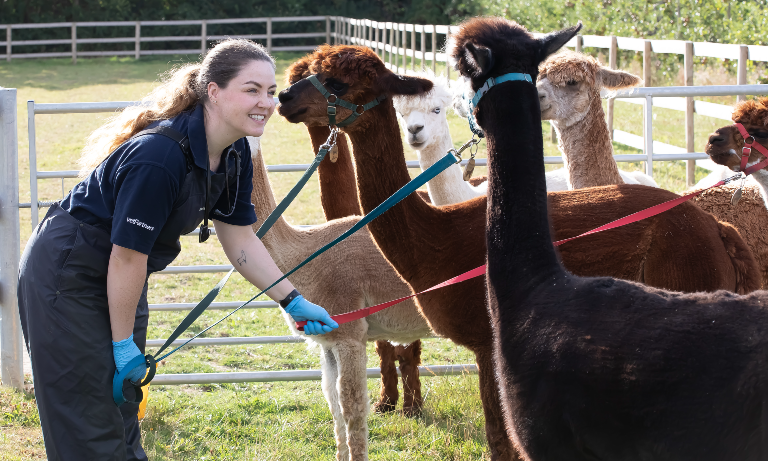Standing up for the veterinary profession
08 Aug 2024
25 Nov 2024 | Ami Sawran
Ami Sawran, Clinical Director of Westpoint Farm Vets, shares guidance for farm vets on responsible antimicrobial use in camelids.

Camelids such as llamas and alpacas are not a traditional livestock species, nor listed as food producing animals (FPA) in the UK, so the impact of antimicrobial usage in these species seems minimal in terms of scale and public health. However, this does not mean that it should not be judicious, targeted and routinely evaluated.
Responsible antimicrobial prescription
Most vets dealing with camelids have confidence applying principles of responsible antimicrobial use to prescribe appropriate, targeted therapy. Many rely on a Camelid Formulary to facilitate this, utilising first lines where indicated, and a sensible approach to critically important antimicrobials (CIAs).
There is sometimes a disconnect between what is thought appropriate for camelids versus traditional livestock. Emotional connection and value of an animal may be considered in certain circumstances, but the principles of antimicrobial guardianship apply in companion animal medicine just as much as they do in livestock. Pressure from owners can impact decision making, particularly if one is underconfident with camelid species. It has been suggested to me by some owners that camelids require CIAs for certain conditions, for example mycoplasma haemolamae. I have yet to see microbiological evidence for this blanket approach, and it takes some strength of conviction to have these discussions. There is limited pharmacokinetic data available for many medications used in camelid species, so we rely on comparative anatomy and physiology, a degree of extrapolation, and support of our more experienced colleagues.
Importance of preventative care
There are barriers to devising treatment plans in camelids – firstly, no medications are licenced in the UK, hence POM-VPS products for other species are subject to veterinary prescription. This can trigger frustration in owners, who may be used to obtaining anthelmintics over the counter for sheep and cannot understand why camelids should be any different. This justification often falls to vets, who must convey the value of medicines compliance and prescription visits. These, while viewed unfavourably by some, are opportunities for us to learn about different camelid management systems, and devise treatment protocols that streamline veterinary care, leading to fewer callouts for preventable issues, and appropriate triage of unwell animals.
The top reasons vets see camelids are preventable with routine husbandry and appropriate parasite management, which we cannot influence unless we have good relationships and regular touchpoints with our camelid clients. Animals not debilitated by parasites are less likely to require anthelmintics, and in turn, antimicrobials for secondary bacterial infections.
Challenges are presented in the management of common conditions such as osteomyelitis of the mandible; a painful, chronic condition which can result in permanent bone remodelling. Extended antimicrobial courses may be prescribed, but this should be on the understanding that a failure of treatment warrants further diagnostics-imaging, or surgical curettage (and possibly culture) of the infection site. Many have hopeless prognoses if diseased bone is not removed, and it is worrying that some may be on long term or repeated antimicrobial courses without hope of resolution, presenting significant welfare concerns, as well development of resistant bacteria.
Prescribing challenges
Because nothing is licenced, misunderstandings can arise that anything can be given, leading to illegal importation of POMVs utilised in other countries by some clients. This sets a dangerous precedent where inappropriate dosing regimes and a lack of treatment traceability can threaten animal welfare and undermine veterinary care. This is reportable to the Veterinary Medicines Directorate.
Camelids are not technically listed as food producing animals; however, they appear in the food chain in small numbers. Camelid vets should state statutory withdrawals, and advocate medicine recording. Many of my colleagues treat camelids as if they are FPA, avoiding banned medications, and those without documented residues, as one cannot effectively ‘sign them out’ of the food chain. Doing so (or not) remains part of a practitioner’s clinical judgement, and welfare remains paramount, but this has been, thus far, simple to navigate.
There are instances where vets are not the first port of call when a camelid becomes unwell, leading to inappropriate advice and occasionally illegal sharing of medicines, as well as treatments that ‘happened to be on the shelf’ for other reasons. This causes considerable frustration to the practitioner who may arrive to see a case that has already had the ‘kitchen sink’ approach. This is understandable if one considers that there are still practices that do not feel that they can offer a good standard of care to camelids, which facilitates ‘Facebook Vetting’ – to which I say, please make the most of available CPD. The British Camelid Veterinary Society, and other camelid vets offer this.
It’s my aim that all practitioners feel empowered to utilise their transferrable skills from other farm species to offer a basic level of care to camelids. They are, after all, here to stay, and since they suffer from some of the same infectious diseases as cattle and sheep, we have a responsibility to ensure their health to protect all livestock species.
Get tailored news in your inbox and online, plus access to our journals, resources and support services, join the BVA.
Join Us Today